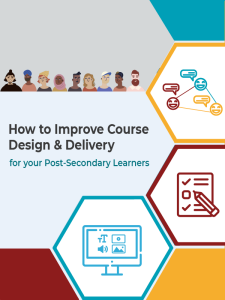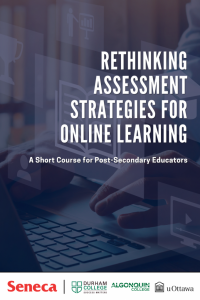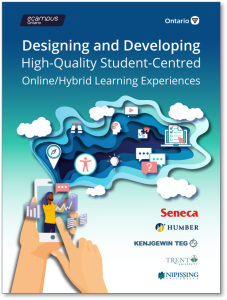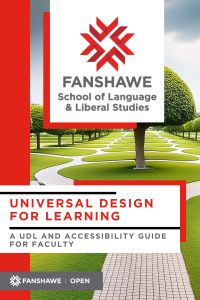
The following is an overview of various open educational resources recommended to help you design and deliver online and blended courses:
- High Quality Online Courses: How to Improve Course Design & Delivery for your Post-Secondary Learners
- Rethinking Assessment Strategies for Online Learning
- Designing and Developing High-Quality Student-Centred Online/Hybrid Learning Experiences
- Universal Design for Learning: A UDL and Accessibility Guide for Faculty.
High Quality Online Courses
 The following is an overview of High Quality Online Courses: How to Improve Course Design & Delivery for your Post-Secondary Learners by the University of Waterloo, Queen’s University, University of Toronto, and Conestoga College. Rather than reproduce the content in this guide, you’re encouraged to explore this resource and apply any techniques you may find helpful in designing your own online courses.
The following is an overview of High Quality Online Courses: How to Improve Course Design & Delivery for your Post-Secondary Learners by the University of Waterloo, Queen’s University, University of Toronto, and Conestoga College. Rather than reproduce the content in this guide, you’re encouraged to explore this resource and apply any techniques you may find helpful in designing your own online courses.
This resource contains the following sections:
Resource Overview
The goal of this course is to enable you to apply principles of quality design to your online course, whether you’re creating a new online course, revising an existing online or remote course, or facilitating your first-ever online course. Your own goals in taking this course will determine the outcomes you take away, but successful completion of the entire course will enable you to
- recognize and implement key features of quality in learner-centred online course design;
- develop a set of learning outcomes for your online course that are explicit, measurable, and align with your content, activities, and assessments;
- create a varied assessment scheme that scaffolds and supports the learning outcomes of the course and promotes academic integrity;
- incorporate principles of equity, diversity, and inclusion (EDI) into your course design for the benefit of all learners;
- apply principles of Universal Design for Learning (UDL) and accessibility into your course design to ensure a more equitable learning experience;
- structure and present your online content in ways that facilitate student learning and foster a sense of community;
- employ effective facilitation strategies when delivering your online course; and
- create a plan for revising your course at the end of the course offering.
Course Overview
This course consists of four modules. The modules are organized according to the typical stages of development of an online course. These modules can be completed sequentially or as stand-alone modules, allowing you to begin at whatever development stage/module aligns best with your goals. Each module includes strategies, design templates, practical examples, and applied activities that help you actively build/revise/facilitate your own online course as you progress through the content. If you are looking for guidance on completing course design, development, or delivery tasks for your own course, the right column in the visual below provides a list of the activities associated with each module. If you’d like to preview these activities, click on the “i” icon to navigate directly to the activity you’d like to complete for your course.
References
This section was reproduced from the following:
“About this course – Start here!” in High Quality Online Courses Copyright © by the University of Waterloo; Queen’s University; University of Toronto; and Conestoga College is licensed under a Creative Commons Attribution-NonCommercial-ShareAlike 4.0 International License, except where otherwise noted.
Rethinking Assessment Strategies for Online Learning
 The following is an overview of Rethinking Assessment Strategies for Online Learning: A short course for post-secondary educators by Seneca College, Durham College, Algonquin College, and the University of Ottawa. Rather than reproduce the content in this guide, you’re encouraged to explore this resource and apply any techniques you may find helpful in designing your own online and blended courses.
The following is an overview of Rethinking Assessment Strategies for Online Learning: A short course for post-secondary educators by Seneca College, Durham College, Algonquin College, and the University of Ottawa. Rather than reproduce the content in this guide, you’re encouraged to explore this resource and apply any techniques you may find helpful in designing your own online and blended courses.
This resource contains the following sections:
Exemplar Resource
This course also has a companion resource entitled Rethinking Assessment Strategies for Online Learning – Exemplar Collection, which is a collection of sample authentic and alternative assessments for your use. These exemplars were generously shared by instructors from various colleges and universities across Ontario. Refer to these exemplars for inspiration as you develop your own authentic and alternative assessments or directly adapt them to your course.
Why Rethink Assessment?
The challenges are familiar. How do we assess learners in our online courses in ways that promote student success? How do we ensure academic integrity in online assessment? How do we respect privacy, recognize diversity, and establish equity in our online assessment and feedback practices? Moreover, how do we accomplish this within the limitations of time and available teaching resources?
Rethinking Assessment Strategies for Online Learning: a short course for post-secondary educators is a response to online assessment concerns that we have received from our faculty, instructors, teaching assistants, and students. The widespread offering of micro-credentials, HyFlex, hybrid, and fully online learning opportunities has shifted the post-secondary educational landscape and refocused considerable attention on assessment strategies. We believe the time has come to re-examine how we evaluate and provide feedback to our learners.
Download transcript [PDF] Watch the Welcome to Rethinking Assessment Strategies video [0:48}
References
This section was reproduced from the following:
“Welcome” in Rethinking Assessment Strategies for Online Learning Copyright © 2022 by Seneca College; Durham College; Algonquin College; and University of Ottawa is licensed under a Creative Commons Attribution-NonCommercial-ShareAlike 4.0 International License, except where otherwise noted.
Rethinking Assessment Strategies for Online Learning – Exemplar Collection Copyright © by Seneca College; Durham College; Algonquin College; and University of Ottawa is licensed under a Creative Commons Attribution-NonCommercial-ShareAlike 4.0 International License, except where otherwise noted.
Designing and Developing High-Quality Student-Centred Online/Hybrid Learning Experiences
 The following is an overview of Designing and Developing High-Quality Student-Centred Online/Hybrid Learning Experiences by Seneca College, Durham College, Algonquin College, and the University of Ottawa. Rather than reproduce the content in this guide, you’re encouraged to explore this resource and apply any techniques you may find helpful in designing your own online and blended courses.
The following is an overview of Designing and Developing High-Quality Student-Centred Online/Hybrid Learning Experiences by Seneca College, Durham College, Algonquin College, and the University of Ottawa. Rather than reproduce the content in this guide, you’re encouraged to explore this resource and apply any techniques you may find helpful in designing your own online and blended courses.
This resource contains the following sections:
Resource Overview
This collaborative project between Seneca College, Humber College, Kenjgewin Teg, Trent University and Nipissing University provides learners with the knowledge and skills to design, develop and deliver high-quality, interactive and engaging online learning experiences.
Over the past few years, there has been an unprecedented challenge for academic institutions across both college and university sectors to shift from in-person to online course delivery. But, with limited resources to guide and support high-quality online course development, how can we be certain that all the effort put into online development results in a quality learning experience that sets students up for success?
This accessible and flexible four-week asynchronous online course provides learners with strategies and tools to create well-organized, accessible and culturally inclusive courses that engage learners and help them achieve their learning goals in a virtual environment.
Each of the four modules contained within the course are learner-centred and include transferable supports that allow for reskilling and upskilling of faculty. Post-secondary institutions can use the course to support faculty development and use the content within the course (e.g., authentic assessment, Indigenous Ways of Knowing, and designing with international students in mind) to frame new online courses. This online course will support colleges and universities in driving high-quality and innovative online/hybrid learning by modelling best practices in online course design and delivery.
Download transcript [PDF] | Watch the Introductory Video [2:52].
References
This section was reproduced from the following:
“Welcome” in Designing and Developing High-Quality Student-Centred Online/Hybrid Learning Experiences Copyright © 2022 by Seneca College; Humber College; Kenjgewin Teg; Trent University; and Nipissing University is licensed under a Creative Commons Attribution-NonCommercial 4.0 International License, except where otherwise noted.
Universal Design for Learning: A UDL and Accessibility Guide for Faculty
 The following is an overview of Universal Design for Learning: A UDL and Accessibility Guide for Faculty by Andrew Stracuzzi. This guide is intended to support faculty in implementing the principles of UDL within their teaching practices at Fanshawe College.
The following is an overview of Universal Design for Learning: A UDL and Accessibility Guide for Faculty by Andrew Stracuzzi. This guide is intended to support faculty in implementing the principles of UDL within their teaching practices at Fanshawe College.
UDL is a powerful approach that allows you to make sure the greatest range of students can access and engage in learning, not just certain students. Thus, Universal Design for Learning: A Faculty Guide intends to provide educators with strategies and resources to support greater accessibility and inclusion in higher education at Fanshawe College.
Resource Overview
This guide is built upon the teaching philosophy that even taking one small step (that is, making a single pointed change in your course) to provide an additional method of access, option for assessment, or strategy for engagement is going to make a positive impact upon the learning experience and move your course towards greater inclusivity and accessibility. This is similar to the “plus one” approach commonly used by UDL practitioners and advocates (for example, see this video by Thomas J. Tobin: UDL plus-one). The broad idea is not to get overwhelmed at the work of applying UDL principles – the UDL approach and this book are not meant to serve as a checklist of all the “must-do” tasks for your course. Instead, they are meant to provide a framework and a helpful set of guidelines for the ongoing, reflective, personal, and iterative work of course design and teaching.
This book is designed to be used in a modular fashion – that is, you may find only certain chapters or sections of it applicable to the UDL work you are engaged in at any particular time. In a broad overview, the following topics are covered:
- Chapter 1: Introduction to Universal Design for Learning will provide the research foundations of UDL, an explanation for each of the three principles of UDL, and some guidelines for approaching course design (or redesign) from a UDL perspective.
- Chapter 2: Assessment and UDL will dig more deeply into using the UDL principles to design flexible and rigorous assessments.
- Chapter 3: UDL & Best Practices for Technology-Enabled Learning will examine web accessibility to reduce barriers to learning and provide additional technical guidance and information specific to the Fanshawe technology ecosystem.
In addition, there are a series of appendices to help you navigate the basics of creating accessible documents, including MS PowerPoint, MS Word, and Adobe PDFs.
References
This section was reproduced from the following:
Universal Design for Learning Copyright © 2023 by Andrew Stracuzzi is licensed under a Creative Commons Attribution-NonCommercial-ShareAlike 4.0 International License, except where otherwise noted. This edition has been adapted from Universal Design for Learning: One Small Step, originally published by Sara Dzaman, Derek Fenlon, Julie Maier, and Toni Marchione from the University of Saskatchewan, with additional content adapted from the Accessibility Handbook for Teaching and Learning by Briana Fraser and Luke McKnight from Langara College.
Additional Resources
 The following are additional open educational resources for this topic:
The following are additional open educational resources for this topic:- Principles of Blended Learning: Shared Metacognition and Communities of Inquiry
- Teaching in Blended Learning Environments: Creating and Sustaining Communities of Inquiry
- Assessment Strategies for Online Learning: Engagement and Authenticity
- The Blended Learning Toolkit by the University of Central Florida (UCF)
- Teaching with Technology by Steel Wagstaff

